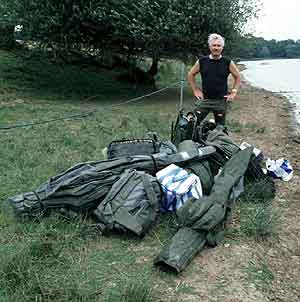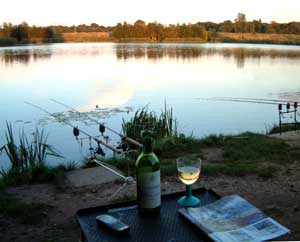Every angler has ‘Justins’ in his tackle box or rod bag. They are those pieces of equipment that you have to take with you ‘just in’ case you need them. I suspect that we have all at some time or another sat down and said that we would clear out all the unnecessary bits and pieces, and only take the amount of tackle that we actually need for that particular trip. We arrange all the various bits into piles or boxes at home and say that pile/box is for pike, that lot is pole gear, that’s all the carp tackle, etc, etc. Then after three or four trips you notice that your original selection needed fine tuning and that this bit has to come on every trip, this rod is always going to come in handy one day, and if you take that rod then you need that reel to go with it, and that reel needs two spare spools just in case.
|
|
| |
On my return home I found that my rod bag contained eight rods, possibly one or two too many! I had two umbrellas, because the brollycamp fitted nicely over one and the other was used to keep the rain off all the remaining tackle! There was also more than sufficient rusty, corroded shut, flat-ended and bent rod rests as well as a selection of various bank sticks, telescopic and otherwise. Apart from two huge keepnets, which I knew to be redundant because, 1) I rarely caught any fish, and 2) if I did they were never put in a keepnet, I will state in my defence that I did only have one bedchair! My tackle box(es) yielded seven reels (including fixed spools, multipliers and a centre-pin) and a vast assortment of spare spools, some of which actually fitted those reels.
Of the lesser items, I had nearly twenty swimfeeders, (I should mention that this was supposed to be my pike tackle), a complete set of brass and plastic bread punches, three empty bait boxes, a full set of stick and waggler floats, WF8 fly line and a shooting head, an assortment of swingtips and quivertips, any number of plastic disgorgers and rod rest tops of the type sellotaped to fishing magazines, and packet after packet of hooks to nylon, some of which were old enough to have been tied by Edgar Sealey himself.
Further down in the debris at the bottom of the boxes were all those items that, although broken, you promise yourself you will repair one day, and those other items that are part of some set or other and you have to keep them because you know that the missing piece will turn up someday, and, of course, the trophies – which are things you have found.
|
|
| |
The spare rod approach has much to recommend it because it offers so many options to entertain your fellow anglers and passers-by, of which there will be many the moment word gets out that you are attempting a retrieval. The best outcome but rated at around 100/1 is that on your first attempt you manage to catch hold of the snagged object and gently lift it from the branch and bring it safely back to the bank.
There are, however, much better odds and they start at around 2/1, this being that no matter how hard you wave and lunge about, you cannot manage to get the tip ring to catch onto anything. If this happens during summer the branch will end up defoliated and the float/spinner will be even more visible.
At 5/1 is the ‘double whammy’ whereby you manage to dislodge the item and it falls into the water. If this happens on a lake you can continue trying to pull it into the bank using the rod tip, or you may be able to reach it with a full stretch of the landing net. If both of these fail you of course wind in one of the outfits you were fishing with and start casting at the item with the intention of hooking and reeling it in. If the item is dislodged into a river you have no option but to pursue it vigorously with the landing net because if you don’t it will just end up in some other bugger’s swim after you have done all the hard work!
|
|
| |
1) You give the rod a gentle shake, the spinner comes loose and you collect your prize (This has never been known to happen, but there has to be a remote possibility)
2) You give the rod a vigorous tug and
a) The spinner comes loose and then whistles towards you, hooks first.
b) It comes loose, but travels in the opposite direction to the centre of the lake/opposite bank of the river.
c) The top section of your rod comes off and does either a) or b) above, or c) ends up hanging from the tree/bush attached to the spinner.
There is no further advice that can be give at this point, except to say that wisdom should dictate that if the item is up a tree the previous owner probably tried and failed to retrieve it because of the level of difficulty.
Returning to the plot, it has to be said that, as stated, I admit to having trophies in the bottom of my tackle box. The reason they were there is because when you do manage to ‘find’ something it is invariably chipped, broken or rusty, so you sling it in the box ‘Just in case!’ One final point is if you had religiously followed the principal of not carrying unwanted tackle in the first place you wouldn’t have a spare float rod with which to attempt a retrieval………..
There is a cautionary tale I will relate with regard to ‘Justins’. Having decided to rid myself of unnecessary weight and therefore tackle, I sold a number of cherished rods (6 in total!) and purchased a matching pair of Mr. Daiwa’s finest all-singing all-dancing 2.75 lb 12′ carbon rods which would do just about everything.
In my new ruthlessly efficient mode I strode up the banks at Startops with only these two rods in one hand and a small rucksack on my shoulder, all that I actually needed for one day’s deadbaiting. Bob, my fishing companion, arrived with the ‘normal ‘ amount of gear and had to take two trips to heave it all to the top of the bank. I, of course, had already tackled up and was ready to commence battle while Bob was still recovering from his exertions, leaving me with an almost spiritual feeling of wellbeing (smugness!).
|
|
| |
The mackerel tail was retrieved by hand-lining and the broken rod put away.
Bob regained his composure long enough to begin fishing in total silence while I brought out the other new rod and carefully tackled up in preparation to cast again. The second cast was made more gingerly and perhaps because of that this rod snapped three feet from the tip!! At this point I did become concerned for Bob’s welfare because I was sure he was about to choke! The two rods were returned to Daiwa for investigation and the conclusion was that they were both part of a faulty batch, having missed an additional strengthening wrap during manufacture. Both rods were replaced with the revised models and apologies. This did not help on the day in question as I was now in the position of not being able to fish because I didn’t have any spare rods and so had to go to Bob and beg to borrow a couple of his ‘Justins’ so that I could continue fishing, not having bought any of my own!
I am sure that there is a moral tale in this somewhere about not carrying any unwanted tackle around with you, but on the other hand you never know when you will need something, just in ………
















